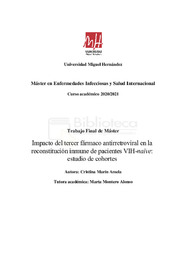Título :
Impacto del tercer fármaco antirretroviral en la reconstitución inmune de pacientes VIH-naïve: estudio de cohortes |
Autor :
Marín Amela, Cristina |
Tutor:
Montero Alonso, Marta |
Editor :
Universidad Miguel Hernández de Elche |
Departamento:
Departamentos de la UMH::Medicina Clínica |
Fecha de publicación:
2021-09-10 |
URI :
http://hdl.handle.net/11000/27294 |
Resumen :
Antecedentes y objetivo: La ratio CD4/CD8 es indicador de inmunosenescencia y predictor de eventos sida, ENOS y mortalidad, pero la evidencia del efecto del TAR sobre el mismo no es concluyente. El objetivo del estudio es evaluar el impacto sobre el cociente de diferentes familias FAR. Metodología. Estudio de cohorte retrospectiva en el cual se incluyeron los pacientes VIH naïve en seguimiento en el Hospital UyP La Fe (Valencia) entre 2009-2019. Se analizó la evolución del cociente CD4/CD8 según familia FAR y la asociación del mismo con la incidencia de sida, ENOS y mortalidad durante los 3 primeros años. El análisis estadístico se realizó mediante un modelo de regresión lineal mixta y regresión logística multivariante. Resultados: Se incluyeron 249 pacientes de los cuáles recibieron 89 INI, 70 IP/p y 90 ITINN. Los pacientes con INI presentaron una mediana basal del cociente CD4/CD8 de 0.36 (RIC 0.21, 0.52) sin diferencias significativas respecto a los IP/p y los ITINN. El aumento porcentual a las 48 semanas fue de 0.716 en escala logarítmica [IC95% (0.581, 0.851) p<0.001], sin presentar diferencias estadísticamente significativas respecto a los IP/p e ITINN. En el análisis multivariante la OR de ENOS fue 1.52 (IC95% [1.09, 2.14] p = 0.014). Conclusiones. En nuestra cohorte no se observaron diferencias estadísticamente significativas en el aumento del cociente CD4/CD8 entre las tres familias. Mientras los IP/p mostraron un aumento del recuento CD4 superior respecto a los INI, estos presentaron un control de la CV más precoz a las 24 semanas.
Background and objective. The CD4/CD8 ratio is an indicator of immunosenescence and
a predictor factor of AIDS, non-AIDS, and mortality, but evidence about the effect of ART
on it is not conclusive. The aim of this study was to evaluate the impact of different ARD
families on the ratio CD4/CD8.
Methodology. A retrospective cohort study was developed including HIV-naive patients
followed up at the UyP La Fe Hospital (Valencia) who started ART in the period between
2009-2019. The CD4/CD8 ratio evolution was studied in relation to different ARD
families and its association with the incidence of AIDS, non-AIDS, and mortality during
the first 3 years. Statistical analyses were performed using mixed linear regression and
multivariate logistic regression.
Results. A total of 249 patients were included, whom 89 received an INSTI-based
therapeutic regime, 70 PI/p-based, and 90 NNRTI-based. Patients with INSTI had a
median baseline CD4/CD8 ratio of 0.36 (IQR 0.21, 0.52) without significant differences
respect PI/p and NNRTI patients. Patients with INSTI had a percentage increase of 0.716
on a logarithmic scale [95% CI (0.581, 0.851) p <0.001] at 48 weeks, but these
differences were not statistically significant respect to PI/p and NNRTI patients. In the
multivariate regression analysis, the OR of NOS was 1.52 (IC95% [1.09, 2.14] p =
0.014).
Conclusions. No statistically significant differences were found on the CD4/CD8 ratio in
relation to the different ARD families in our cohort. While PI/p patients showed a higher
CD4 count increase than INI patients, these achieved VL control at 24 weeks earlier than
PI/p patients.
|
Palabras clave/Materias:
Ratio CD4/CD8
SIDA
ENOS
INI |
Área de conocimiento :
CDU: Ciencias aplicadas: Medicina: Patología. Medicina clínica. Oncología |
Tipo de documento :
info:eu-repo/semantics/masterThesis |
Derechos de acceso:
info:eu-repo/semantics/openAccess |
Aparece en las colecciones:
TFM-M.U Enfermedades Infecciosas y Salud Internacional
|
 La licencia se describe como: Atribución-NonComercial-NoDerivada 4.0 Internacional.
La licencia se describe como: Atribución-NonComercial-NoDerivada 4.0 Internacional.
.png)
